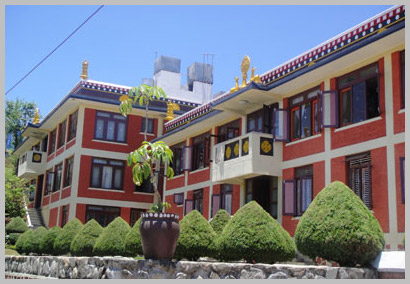Namo Buddha Meditation and Education Centre
All the courses are in Tibetan. Classes are held in Nepal during summer and in India during winter. |
 Namo Buddha, one of the three major stupas in Nepal, is where our supreme teacher Shakyamuni, while still on the path of learning, took birth as the prince Nyingthob Chenpo. It is the supreme and special place where without holding back in the least, he offered his body to a tigress on the verge of starvation. If Dharma activity could happen in such a place, then in the whole world and, in particular in the lands of Nepal and Tibet, the problems of degenerate times, such as disease, famine, war, and disputes, would be pacified, and, further, well being and goodness would grow and flourish. Being certain that all of this happens through the blessings of the teacher and the teachings, Thrangu Rinpoche began to build a new monastery at Namo Buddha in 1978.
Namo Buddha, one of the three major stupas in Nepal, is where our supreme teacher Shakyamuni, while still on the path of learning, took birth as the prince Nyingthob Chenpo. It is the supreme and special place where without holding back in the least, he offered his body to a tigress on the verge of starvation. If Dharma activity could happen in such a place, then in the whole world and, in particular in the lands of Nepal and Tibet, the problems of degenerate times, such as disease, famine, war, and disputes, would be pacified, and, further, well being and goodness would grow and flourish. Being certain that all of this happens through the blessings of the teacher and the teachings, Thrangu Rinpoche began to build a new monastery at Namo Buddha in 1978.
Vasubhandu had the following to say on how to follow the teacher, the perfect and complete Buddha, how to practice genuine Dharma, and how to hold the teachings:
There are two aspects to the Buddha's teaching:
The very essence of the scriptures and of realization.
One should hold these in mind, speak about them,
And practice them. Do only that.
So since one must engage in both aspects of the precious teachings-scriptural study and meditative realization-one listens and reflects on the scriptural Dharma, the words of the Buddha, and the treatises. If there were no institute for higher studies where one listens to explanations and no place of practice where one brings into experience the Dharma to be realized-the path of the sutra- and mantrayanas-what are called places of Dharma and monasteries would be a mere reflection of genuine Dharma. For this reason, places of study and practice, which are the heart of the Buddha's teaching, are extremely important. First, in the institutes for higher study, one studies the sutra and mantra traditions along with the various sciences and, thereby, one can generate a special kind of confidence in the teachings, the genuine Dharma, and the one who taught them, the unsurpassed teacher, the Buddha and Bhagawan.
These treatises that are able to bring about certainty in the teachings were composed by Arya Nagarjuna, Acharya Asanga, Dharmakirti, Vasubhandu, Chandrakirti, and others: they are the words of the great and famous panditas from India. The four major treatises deal with Madhyamaka, the Prajna Paramita tradition, the Abhidharma, and the Vinaya. The treatises on Pramana (Dialectics) are concerned with reasonings that lead to direct and inferential valid cognition. The great treatises include the famous five divisions, and in particular, those great treatises forming a basis for the special stages of meditation that clearly reveal the true nature of the mind, the body, and the deity: The Supreme Continuum, The Profound Inner Nature, and The Two Volumes on the Tantra of Hevajra. One should study and reflect on these.
In order to understand in itself the intention of these texts, which is profound and difficult to fathom, one studies various commentaries from the Kagyu tradition, written by the Third Gyalwang Karmapa, Rangjung Dorje, by the Seventh Gyalwang Karmapa, Chödrak Gyamtso, by the Eighth Gyalwang Karmapa, Mikyo Dorje, and also by Situ Chökyi Jungne, Kongtrül Yönten Gyatso, and others. By studying for five or ten years, one understands just as it is the thought of the sutra tradition's definitive meaning and the profound tantras of the secret mantrayana. In this way, the key points of Buddhist view, meditation, and conduct are fully comprehended, and the tradition of listening and reflecting, of being teacher and student as practiced at the great Nalanda University and monastic complex does not deteriorate. Studying at an institution of higher learning where the commentarial lineage has been maintained without interruption, one brings to perfection one's knowledge and qualities, thereby creating great benefits. Further, engaging in explanation, debate, and composition is a wonderful way to spread the precious teachings of the Buddha and insure that they remain for a long time.